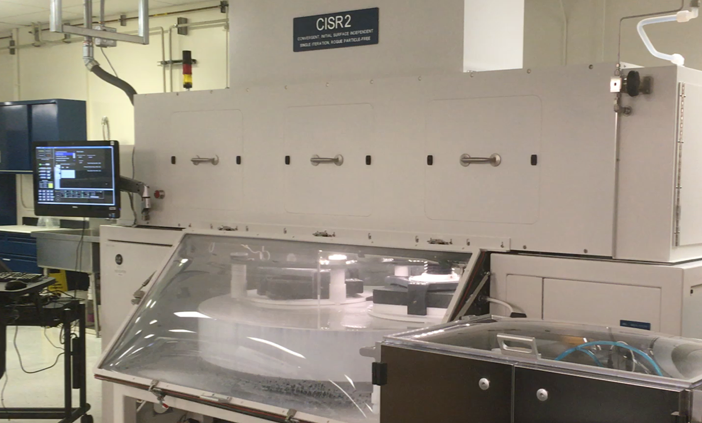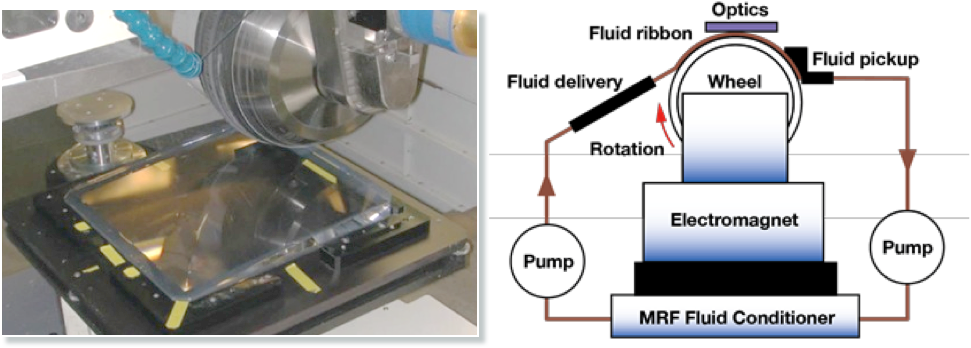Our goal is to understand the fundamentals of optical finishing processes and their effects on observables, such as material removal, surface figure, surface quality, and optic damage resistance. We also work to develop novel finishing processes for precision optics to meet the needs of the National Ignition Facility (NIF) and other laser systems.
Convergent polishing
CISR (Convergent, Initial Surface Independent, Single Iteration, Rogue-particle free) is a novel polishing system and method for finishing flat and spherical glass optics in which a workpiece, independent of its initial shape (i.e., surface figure), will converge to a final surface figure with excellent surface quality under a fixed, unchanging set of polishing parameters in a single polishing iteration.
CISR allows high-quality optical components to be made more rapidly and repeatedly, with less metrology and labor, resulting in lower unit costs. Fabrication of flats and spheres of various shapes, sizes and aspect ratios on various glass materials has been demonstrated. The polishing system was engineered and developed at LLNL as a result of extensive finishing science studies and has now been scaled to accommodate parts that are up to 40-cm square.

T. Suratwala, R. Steele, M. Feit, R. Dylla-Spears, R. Desjardin, D. Mason, L. Wong, P. Geraghty, P. Miller, and N. Shen, "Convergent Polishing: A Simple, Rapid, Full-Aperture Polishing Process of High Quality Optical Flats & Spheres," Journal of Visualized Experiments 94, e51965 (2014).
T. Suratwala, R. Steele, M. Feit, R. Desjardin, and D. Mason, Convergent Pad Polishing, International Journal of Applied Glass Science, 3, 14 (2012).
T. Suratwala, M. Feit, and R. Steele, Toward Deterministic Material Removal and Surface Figure During Fused Silica Pad Polishing, Journal of the American Ceramic Society, 93 [5], 1326-1340 (2010).
Magnetorheological finishing
Magnetorheological finishing (MRF) is a small tool optical finishing process combining interferometry, precision equipment, and computer control. It utilizes a sub-aperture polishing tool (or removal function) generated by the interaction of a magnetic field and an iron-based MR fluid containing microscopic abrasive particles such as ceria or nano-diamonds. Material is removed in the area where the optic is immersed into the fluid ribbon. Surface polishing is accomplished by rastering or rotating the optic through the fluid. The MRF tool can be used for final figure corrections on optics and is used to imprint a diffractive pattern onto the continuous phase plates (CPPs) prior to final use.

J.A. Menapace, P.E. Ehrmann, A.J. Bayramian, A. Bullington, J.M.G. Di Nicola, C. Haefner, J. Jarboe, C. Marshall, K.I. Schaffers, C. Smith, "Imprinting high-gradient topographical structures onto optical surfaces using magnetorheological finishing: manufacturing corrective optical elements for high-power laser applications," Applied Optics (2016), 55, 5240-5248.
J. A. Menapace, "Developing Magnetorheological Finishing (MRF) Technology for the Manufacture of Large-Aperture Optics in Megajoule Class Laser Systems," SPIE 7842 (2010).
J. A. Menapace, P. J. Davis, R. A. Steele, M. R. Hachkowski, A. Nelson, and K. Xin, "MRF Applications: On the Road to Making Large-Aperture Ultraviolet Laser Resistant Continuous Phase Plates for High-Power Lasers," SPIE 6403 (2007).
J. A. Menapace, P. J. Davis, R. A. Steele, L. L. Wong, T. I. Suratwala, and P. E. Miller, "MRF Applications: Measurement of Process-Dependent Subsurface Damage in Optical Materials Using the MRF Wedge Technique," SPIE 5991 (2005).
J. A. Menapace, S. N. Dixit, F. Y. Genin, and W. F. Brocious, "Magnetorheological Finishing for Imprinting Continuous Phase Plate Structures onto Optical Surfaces," SPIE 5273 (2004).
Finishing science
Due to the complex mechanical and chemical interactions that occur, optical finishing has historically remained a largely “artisan” process for hundreds of years. Our efforts have been aimed improving scientific understanding of the finishing process. The scope includes understanding the:
- Physics and chemistry that control material removal on the workpiece both spatially and temporally to control the surface figure
- Microscopic interactions during polishing and determining the factors that control the surface roughness of a finished optic
- Creation and development methods to reduce subsurface damage during grinding and polishing
Although much of the work has been conducted on fused silica, new studies are being focused on a broader range of optical substrates.
- Rebecca Dylla-Spears
- Paul Ehrmann
- Eval Feigenbaum
- Joe Menapace
- Phil Miller
- Nan Shen
- William Steele
- Tayyab Suratwala
- Lana Wong
T.I. Suratwala, W. Steele, M. D. Feit, N. Shen, L. Wong, R. Dylla-Spears, R. Desjardin, S. Elhadj, P. E. Miller. Relationship between surface μ-roughness & interface slurry particle spatial distribution during glass polishing. Journal of the American Ceramic Society.
R. Dylla-Spears, L. Wong, P.E. Miller, M. Feit, W. Steele, T. Suratwala. Adsorption of silica colloids onto like-charged silica surfaces of different roughness, Colloids and Surfaces A: Physicochemical and Engineering Aspects (2017) 520, 85-96.
T. Suratwala, W. Steele, M. Feit, N. Shen, R. Dylla-Spears, L. Wong, P. Miller, R. Desjardin, S. Elhadj. Mechanism and Simulation of Removal Rate and Surface Roughness During Optical Polishing of Glasses. Journal of the American Ceramic Society, 99 [6] 1974-1984 (2016).
N. Shen, T. Suratwala, W. Steele, L. Wong, M. Feit, P. Miller, R. Dylla-Spears, R. Desjardin. Mechanism and Simulation of Removal Rate and Surface Roughness During Optical Polishing of Glasses, Journal of the American Ceramic Society, 99, 1477-1484 (2016).
T. Suratwala, W. Steele, L. Wong, M.D. Feit, P.E. Miller, R. Dylla-Spears, N. Shen, R. Desjardin. Chemistry and Formation of the Bielby Layer During Polishing of Fused Silica Glass, Journal of the American Ceramic Society, 98, 2395-2402 (2015).
R. Dylla-Spears, L. Wong, P.E. Miller, M. Feit, W. Steele, T. Suratwala. Charged micelle halo mechanism for agglomeration reduction in metal oxide particle based polishing slurries, Colloids and Surfaces A: Physicochemical and Engineering Aspects (2014) 447, 32-43.
Suratwala, T; Feit, M; Steele, W; Wong L; Shen N; Dylla-Spears R; Desjardin R; Mason D; Geraghty; Miller P. Microscopic Removal Function and the Relationship Between Slurry Particle Size Distribution and Workpiece Roughness During Pad Polishing, Journal of the American Ceramic Society (2014) 97, 81-91.
T. Suratwala, M. Feit, R. Steele, L. Wong, Influence of Temperature and Material Deposit on Material Removal Uniformity during Optical Pad Polishing, Journal of the American Ceramic Society, 97 [6] 1720-1727 (2014).
M. Feit, R. Desjardin, W. Steele, and T. Suratwala, Optimized Pitch Button Blocking for Polishing High-Aspect Ratio Optics, Applied Optics, 51 [35] 8350-8359 (2012).
T. Suratwala, R. Steele, M.D. Feit, L. Wong, P. Miller, J. Menapace, P. Davis. Effect of rogue particles on the sub-surface damage of fused silica during grinding/polishing, Journal of Non-Crystalline Solids (2008) 354, 2023-2037.
J. A. Menapace, P. J. Davis, R. A. Steele, L. L. Wong, T. I. Suratwala, and P. E. Miller, Utilization of Magnetorheological Finishing as a Diagnostic Tool for Investigating Three-Dimensional Structure of Fractures in Fused Silica, SPIE 5991 (2005).




